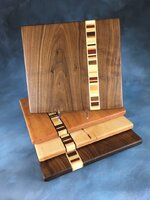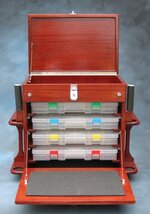mmayo
Member
I make and sell a variety of cutting boards, but a new one came out this week to add to the new stuff for sale at this weekend's Tehachapi Artisan Festival. They are made of American black walnut, cherry and rock maple wood with inlay strips using walnut, purpleheart, poplar, cherry and maple. Contrasting thin strips set off the inlays.
Too pretty to cut on? Just like pretty pens; you only live once.
Too pretty to cut on? Just like pretty pens; you only live once.
Attachments
Last edited:


